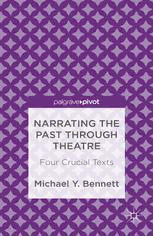
Narrating the Past through Theatre: Four Crucial Texts PDF
Preview Narrating the Past through Theatre: Four Crucial Texts
Narrating the Past through Th eatre DOI: 10.1057/9781137275424 Also by Michael Bennett REASSESSING THE THEATRE OF THE ABSURD: Camus, Beckett, Ionesco, Genet, and Pinter WORDS, SPACE, AND THE AUDIENCE: Th e Th eatrical Tension between Empiricism and Rationalism REFIGURING OSCAR WILDE’S SALOME (editor) EUGENE O’NEILL’S ONE-ACT PLAYS: New Critical Perspectives (co-editor) DOI: 10.1057/9781137275424 Narrating the Past through Th eatre: Four Crucial Texts Michael Y. Bennett DOI: 10.1057/9781137275424 narrating the past through theatre Copyright © Michael Y. Bennett, 2013. Softcover reprint of the hardcover 1st edition 2013ISBN 978–1–137–27541–7 All rights reserved. First published in 2013 by PALGRAVE MACMILLAN® in the United States—a division of St. Martin’s Press LLC, 175 Fifth Avenue, New York, NY 10010. Where this book is distributed in the UK, Europe and the rest of the world, this is by Palgrave Macmillan, a division of Macmillan Publishers Limited, registered in England, company number 785998, of Houndmills, Basingstoke, Hampshire RG21 6XS. Palgrave Macmillan is the global academic imprint of the above companies and has companies and representatives throughout the world. Palgrave® and Macmillan® are registered trademarks in the United States, the United Kingdom, Europe and other countries. ISBN 978-1-349-44616-2 ISBN 978-1-137-27542-4 (eBook) DOI 10.1057/9781137275424 Library of Congress Cataloging-in-Publication Data is available from the Library of Congress. A catalogue record of the book is available from the British Library. First edition: 2013 www.palgrave.com/pivot To Mr. Herbert Pagani, my 10th and 12th grade English teacher, to whom I committed in 12th grade that I would dedicate my fi ft h book (it was supposed to be my fi ft h book of poetry, but dramatic criticism will have to do) And to all of my other infl uential and inspirational teachers, professors, and mentors, each of whom deserve their own book dedication for how they have helped and shaped me: Joseph Black, Nicholas Bromell, Jeff rey J. Cohen, Robert Combs, Joseph Donohue, Jill Kasle, Robert McRuer, Mrs. Marcia Pasco (8th grade), Joseph Skerrett, Jenny S. Spencer, and Adam Zucker DOI: 10.1057/9781137275424 Contents Acknowledgments vii Introduction: Modern Drama and the Translation of History’s Narratives Danton’s Memory: Structural Impossibilities in Büchner’s Danton’s Death Salome’s Tale—Iokanaan’s Telling— Wilde’s Retelling: Historical Relativity and (Un)specifi city in Wilde’s Salome Galileo’s Narrative: Translating History’s “Conditions” in Brecht’s Life of Galileo Conclusion: For All Seasons—Th e Particulars and the Universals of Man in Bolt’s A Man for All Seasons Bibliography Index vi DOI: 10.1057/9781137275424 Acknowledgments Th is book was conceived toward the beginning of my graduate studies at the University of Massachusetts, Amherst, and was initiated both by serving as a Teaching Assistant for Joseph Donohue’s “Modern American Drama” and writing a paper on Danton’s Death for Christine Cooper’s graduate seminar, “19th Century Discourse and the French Revolution.” Th erefore, I am truly indebted to both Donohue and Cooper for helping to implant and develop my ideas from their infancy. I would also like to thank readers of this book—J. Chris Westgate, Donald Jellerson, Rebecca S. Hogan, Joseph Hogan, and Jonathon Walter—who provided me with invaluable feedback. Th anks to Rodopi, Palgrave Macmillan, and the Journal of Th eatre and Drama for allowing me to reprint parts of Chapter 2 that fi rst appeared elsewhere: Michael Y. Bennett, “A Wilde Performance: Bunburying and ‘Bad Faith” in Michael Y. Bennett (ed.) Salome and Th e Importance of Being Earnest,” Refi guring Oscar Wilde’s Salome, Amsterdam: Rodopi, 2011, 177–179, reproduced with permission of Rodopi; Michael Y. Bennett, Words, Space and the Audience: Th e Th eatrical Tension between Empiricism and Rationalism (New York: Palgrave Macmillan, 2012), 54–55, reproduced with permission of Palgrave Macmillan; and Michael Y. Bennett, “Brecht in the Wilde: Salome’s Liminal Spaces and the Storyteller,” Journal of Th eatre and Drama 7/8 (2001/2002): 145–158, reproduced with permission of the Journal of Th eatre and Drama. Also, the section in Chapter 2, Salome: Th e Reading, is reprinted from elsewhere: Copyright © 2004. Th e Johns Hopkins University Press. Th is article fi rst appeared in Th eatre Journal 56.2 (May 2004): 305–306. DOI: 10.1057/9781137275424 vii DOI: 10.1057/9781137275424 Introduction: Modern Drama and the Translation of History’s Narratives Abstract: In order to make sense of the modern “history play,” the Introduction presents the three central assertions of this book. First, this Introduction explores the argument that the narration of the past is largely an act of translation. Second, given that the three chapters in this book are concerned with the historical timeframe related to the telos (which will be explained in more detail), I argue that we must understand these playwrights acting as “modern” historical translators who fuse the past with the future and, like a translation, say something about their moment in time, bringing past, present, and future together in the tense of always : discussing each play’s synchronic limitation to a strict time and place (related to its specifi c historical moment) as well as its diachronic timelessness (speaking to the human condition). And third, modern history plays depart from, especially, early modern history plays in that these modern reincarnations of the form focus not on commemoration (like those in the early modern period) but use history as a means of critique and a way to look at and act in the future. Bennett, Y. Michael. Narrating the Past through Th eatre: Four Crucial Texts. New York: Palgrave Macmillan, 2013. doi: 10.1057/9781137275424. DOI: 10.1057/9781137275424
